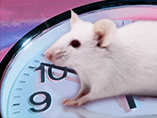
 Last month, the Nobel Foundation recognized Jeffrey Hall, Michael Rosbash, and Michael Young "for their discoveries of molecular mechanisms controlling the circadian rhythm"1. This 24-hour “clock” influences many physiological processes, and has a well-understood biochemical basis elucidated by the work of many researchers over the past few decades. Interestingly, in addition daily circadian cycles, many organisms also display physiological cycles repeating twice a day. Most obviously, coastal animals possess a powerful “circatidal clock”, which oscillated with the 12.4-hour ebb and flow of the tides, influencing locomotion, metabolism, and many other physiological processes2. Even in humans, body temperature, hormone levels, blood pressure, and other functions fluctuate with a predictable 12-hour period, and some human diseases have even been associated with perturbed 12-hour cycles3-9.
Last month, the Nobel Foundation recognized Jeffrey Hall, Michael Rosbash, and Michael Young "for their discoveries of molecular mechanisms controlling the circadian rhythm"1. This 24-hour “clock” influences many physiological processes, and has a well-understood biochemical basis elucidated by the work of many researchers over the past few decades. Interestingly, in addition daily circadian cycles, many organisms also display physiological cycles repeating twice a day. Most obviously, coastal animals possess a powerful “circatidal clock”, which oscillated with the 12.4-hour ebb and flow of the tides, influencing locomotion, metabolism, and many other physiological processes2. Even in humans, body temperature, hormone levels, blood pressure, and other functions fluctuate with a predictable 12-hour period, and some human diseases have even been associated with perturbed 12-hour cycles3-9.
In a fascinating recent study, researchers used mathematical gene expression analysis to identify >3000 mouse genes that follow a 12-hour rhythm10. Many of these genes are associated with endoplasmic reticulum and mitochondrial function and homeostasis, and seem to characterize “Coordinated Rhythms of ER and Mitochondria Actions” (CREMA). Mechanistic analysis of cycling genes using destabilized luciferase reporters, cultured cells, and animal models demonstrated that these 12-hour rhythms are cell-autonomous, are independent of circadian rhythms, and can be entrained by external cues such as feeding and metabolic stress. Knockdown and knockout of circadian rhythm genes did not block the 12-hour cycles.
The transcription factor XBP1s seems to be the master regulator of the 12-hr clock10. ChIP analysis showed cyclical binding/release of XBP1s from 12-hour-cycling genes, mutation of consensus XBP1s binding-sites within promoters disrupts 12-hour cycling, and knockdown of XBP1 suppresses 12-hour rhythms. Altogether, this new study suggests that the 12-hour clock is a prominent and important feature of animal biology. With evolutionary origins likely extending as far back as circatidal clocks in invertebrates, human 12-hour cycles have important implications for health and disease, and much more still needs to be learned.
Cyagen Biosciences can help you harness the experimental power of animal models in your own research. We provide custom mouse and rat models, including transgenics, knockouts and knockins, CRISPR/Cas9 and TALEN genome editing, as well as custom virus packaging, stem cells, and cell culture reagents. Our VectorBuilder platform allows you to design and order custom DNA constructs specific to your experimental needs. Choose from lentiviruses, adenovirus, AAV, shRNA expression vectors, CRISPR/Cas9 vectors, and more!
We will respond to you in 1-2 business days.